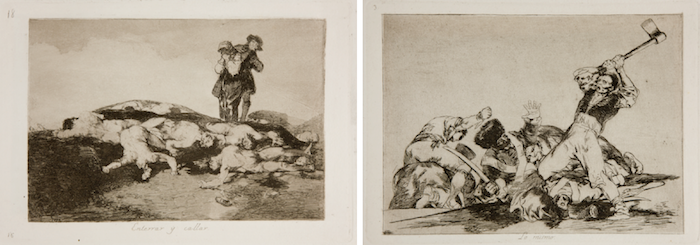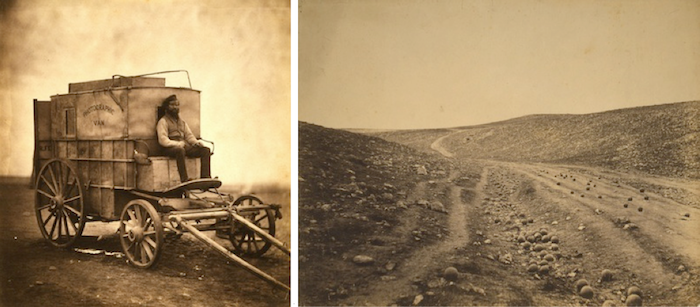No Exposure: Conflict illustration in a photographic world
Throughout history, we have sought ways to illustrate our wars. However, the notion of an ‘artist’ who could produce work in real-time for publication was incongruent. Before the telegraph, news from the front line could take days or even weeks to make it home. Likewise the concept of daily newspapers or periodicals only emerged in the late 18th and early 19th centuries. The vast majority of illustrations were not produced by artists on the front line but by craftsman in the studio, rendering drawings based on oral accounts or testimonies from those who had fought.

From Goya’s The Disasters of War: Enterrar y callar (Bury them and keep quiet) and Lo mismo (The same).
During the Crimean War (1853–56), the burgeoning newspaper industry coincided with technological advances, marking the first occurrence of what we would call conflict reportage. With the invention of the telegraph, correspondents were able to transmit reports from the field to editors back home almost instantaneously.
One of the first ‘artists’ commissioned to document the effects of war was Roger Fenton. He chose photography over illustration but, to avoid offending Victorian sensibilities, refrained from documenting dead bodies. If the first correspondents and photographers demonstrated restraint with this new medium, the emergence of the war photographer during the American Civil War would make it the most documented conflict of the 19th century. The role of the camera in capturing conflict would only expand in the 20th century.
The practicalities of photomechanical reproduction meant that newspapers continued to commission illustrators throughout the 19th century, but artists’ drawings were increasingly based on photographs taken in the immediacy of battle. The inspiration for war artists had shifted from oral histories to photographic templates.
When The War Illustrated was first published at the start of World War I by William Berry, owner of The Daily Telegraph, its focus on illustration over photography saw its circulation peak at over one million. And US generals during World War I and II preferred to enlist artists over photographers in covering frontline conflicts, believing illustrations better expressed the ‘experiences’ of war. The Navy Combat Art Programme even trained artists and illustrators along with regular troops.
However, by the 1930s the popularity of new photographic reportage periodicals, such as Life magazine, began to claim photography as the best way to document conflict. Vietnam became the first ‘photojournalists’ war’ where the true power of the media, let loose without regulation or censorship, saw it fought on televisions and in newspapers, but it also made governments weary of the power of the photographic image.
From the First Gulf War through to the invasion of Iraq in 2003, the embargo on images of dead soldiers and the embedding of photojournalists increasingly stunted photography’s ability to function as a tool of truth and to convey the image of conflict objectively. Its objectivity and immediacy, the very attributes that had made it so appealing to editors and audiences alike, were increasingly used by the authorities to sanitise and censor.
Added to this the increasing proliferation and beautification of the war image – the paradigm shift from ‘dead body’ shock to aesthetic object – made Sontag’s assertion that “a photograph is supposed not to evoke but to show” ever more distorted. Perhaps this demonstrated the limitations of photography in a world dominated by photographs.
There is no question that, at its most visceral, artistic depictions of war have the ability to comment on the human condition at its most vulnerable and nihilistic. Goya’s The Disasters of War prints still resonate – not just as a record of the terror inflicted during Napoleon’s occupation of Spain – but as universal indictment of the horrors of conflict. And yet Goya, unlike 20th century war photographers, never witnessed first-hand the horror he so accurately articulated.
However, just as the US generals viewed the suitability of illustration to capture the experience of war, perhaps Goya’s prints, although not intended as an objective account of what happened, made sense out of the madness of war.
In a time when images of death are everywhere and the demand for up-to-date news coverage can be satisfied by anyone with a phone, perhaps the whisper of the illustrated image really is louder than the shout.
Our upcoming event, In the Picture: Illustration in Times of War, with George Butler will be held on Wednesday 16 April 2014, at 7:00pm. Find out more and book online here.
